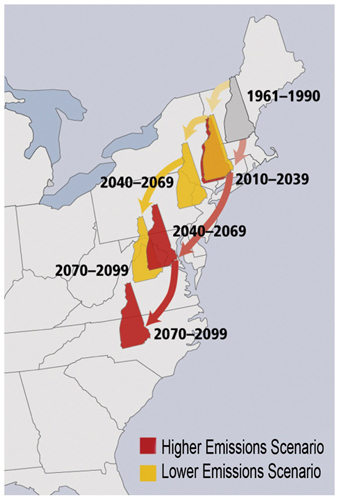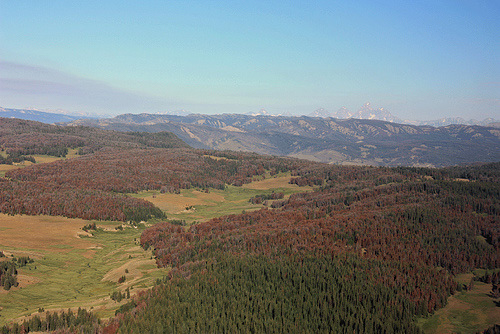Residents of the American West are no stranger to the mountain pine beetle -- a native insect that has been around for thousands of years but, thanks to climate change, has devastated many forests in the West in the past twenty years. Anybody who has driven through Colorado in the last few years, only to be confronted by vast expanses of bright red and gray dying trees, can attest to the havoc that an outbreak of pine beetles can wreak. With climate change, these beetle infestations are occurring over a larger range and moving higher up the mountains because the harsh winters and cold snaps needed to kill back the beetles are not occurring as regularly. Similarly, on the east coast, the related southern pine beetle was prevented from spreading too far north by winters in the northeast. Now everything has changed. Gone are the reliably cold winters of the past, and with them pine beetles have begun a predictable and inexorable march north.
In the West, the devastation is already here.
In response to a petition brought by my organization, the Natural Resources Defense Council, the U.S. government declared that the critically important whitebark pine, which inhabits high elevations throughout the Northern Rockies and has no natural defense against beetle attack, should be protected as an endangered species. Mountain pine beetles have also wreaked havoc in Canada, where a 2012 study concluded that the climate-driven pine beetle outbreak in British Columbia "ranks among the largest ecological disturbances recorded in Canada so far." In fact, changes to Canadian forests are so great that, if they continue, the loss of trees could actually raise local temperatures by as much as 1 degree, a particularly nasty feedback loop.
 Now the same process seems to be repeating itself on the East Coast, where this week southern pine beetles were discovered, for the first time, in New York. Pine beetles first arrived in New Jersey a decade ago, in response to warmer winters (overnight temperatures of 8 below zero are needed to kill them). Previously, the southern pine beetle had never spread north of Delaware. Since then, scientists have been holding their breath. Last year, in the New York Times, George L. Zimmermann, a forest ecologist at Richard Stockton College of New Jersey, sounded a dire alarm: "If the beetle takes off, you could be talking not tens of thousands of [affected] acres, but a hundred thousand or more."
Now the same process seems to be repeating itself on the East Coast, where this week southern pine beetles were discovered, for the first time, in New York. Pine beetles first arrived in New Jersey a decade ago, in response to warmer winters (overnight temperatures of 8 below zero are needed to kill them). Previously, the southern pine beetle had never spread north of Delaware. Since then, scientists have been holding their breath. Last year, in the New York Times, George L. Zimmermann, a forest ecologist at Richard Stockton College of New Jersey, sounded a dire alarm: "If the beetle takes off, you could be talking not tens of thousands of [affected] acres, but a hundred thousand or more."
With this week's news that the southern pine beetle has spread to multiple wildlife refuges within New York's iconic Pine Barrens forest, with global warming predicted to transform the climate of New Hampshire to that of Virginia by the end of the century, and with the forests of New England beckoning, what's going to stop them? Only immediate climate action - which starts with the United States finalizing a strong carbon pollution rule. You can help by taking action with NRDC.
Red Means Dead image by jmogs via Flickr - a forest of lost whitebark pine trees in Wyoming's Wind River Range.
New Hampshire "southern drift" via U.S. EPA.

